Office hours
- Mon - Thurs: 9AM - 5:30PM ET
- Friday: 9AM - 4:30PM ET

Everything DiSC offers a unique personality assessment and interactive training program. Published by John Wiley & Sons (formerly Inscape Publishing), it is designed to help anyone improve soft skills such as communication, self-awareness, emotional intelligence, and team building.
Often, it is used in leadership development. However, it can also help improve sales tactics, organizational culture, and manager/employee relationships. This tool can be both the headliner in your training program or can supplement other training material.
Because this tool can be used in many different ways, we created this guide to help anyone start using this powerful tool. We will cover the following topics:
The Everything DiSC assessment is most known as a personality assessment. It is also referred to as a DiSC profile, DiSC assessment, or, simply, DiSC. It uses William Moulton Marston’s DISC theory as its foundation.
DiSC is an acronym. Marston’s model found that everyone typically exhibits a primary behavioral tendency in one of the four areas:
These behavioral traits help a person identify their DiSC Style:
Let’s be clear, personalities are complex. While it’s true that DiSC will help anyone better understand their personality, it’s important to note that this tool only measures two primary behavioral traits to identify someone’s Behavioral Style. However, these two areas are often the most noticeable traits of anyone’s personality.
The below behavioral dimensions are measured to identify a person’s DiSC Style:
These two behavioral dimensions are measured from a pool of over 100 questions. When taking the assessment, learners are asked to rate themselves on a 5-point Likert scale. The assessment uses an advanced algorithmic question system called adaptive testing so not every question is asked. Rather, the assessment will ask clarifying questions from questions that relate to each style.
Once a person completes their assessment, their behavioral traits are then represented as a single point on a map.

This map can be summed up in a couple of different narratives:
People with DiSC styles at the top of the circle tend to be fast-paced and are often described as assertive, dynamic, and bold. Traditional explanations of the model suggest that these people perceive themselves as more powerful than the environment. Because of this perception, they tend to exert effort to change their circumstances. Conversely, people with styles that fall toward the bottom of the circle tend to be more moderate-paced and are often described as calm, methodical, and careful. Traditionally, these people are thought to perceive themselves as less powerful than the environment, and thus they are more inclined to adapt to existing circumstances.
If you tend to follow your gut and prefer to move quickly through tasks, your assessment would score you on the ‘Active‘ side of this scale.
If you prefer to take your time on activities you are working on and prefer to research your decisions versus jumping quickly into one, you would fall on the ‘Thoughtful‘ side of this scale.
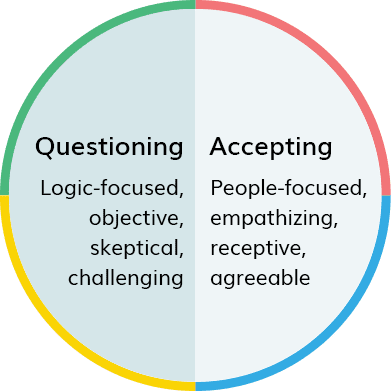
For this map, the assessment will ask questions about how a person interacts with other people and tasks. Here are a couple of narratives to help further explain these sides of the map:
People with DiSC styles that fall toward the left side of the circle are naturally more skeptical in nature and are often described as logic-focused, objective, and challenging. A traditional explanation of these characteristics is that these people see the environment as antagonistic. In other words, they instinctively withhold trust from people and ideas until those outside elements can be thoroughly vetted. On the other hand, people with styles on the right side of the circle are naturally more receptive in nature and are often described as people-focused, empathizing, and agreeable. Traditionally, they are said to see the environment as being aligned with their interests. In essence, they are biased to see the people and ideas around them as favorable and are thus inclined to trust them.
If you tend to lean towards building an objective opinion on both the people you interact with and the information you hear, you would fall on the ‘Questioning‘ side of the map.
On the other hand, if you are more open to new ideas and receptive towards new people, you would fall on the ‘Accepting‘ side of the map.
For both of these traits, you could estimate your style based on how you answer the questions for each behavioral trait. If you want to try this, draw a circle and answer the questions.
Here is an example of how this would work:
For the energy & pace trait, imagine that you prefer to move at a quick pace. You want to engage in new opportunities immediately, and you don’t shy away from making a gut decision even when you know it might be risky.
If you agreed with this narrative, you would have a preference towards action, and you could mark your map like this image.
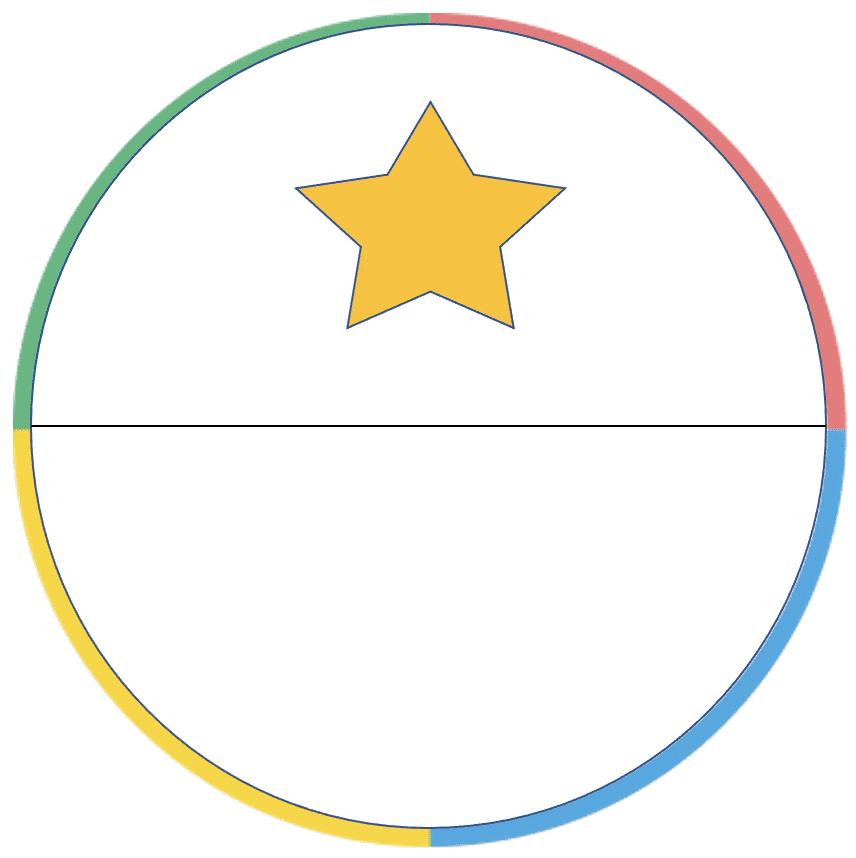

For the environmental preference trait, imagine that you prefer to question new information. It’s not that you don’t trust new information, you just want to make sure you fully understand what’s being communicated to you. When working in a group, you would prefer to stay on task and maintain an objective way of working.
If you agreed with this narrative, you would have a preference towards Questioning, and you would mark your map like this image.
To receive your estimated DiSC style, find the shared quadrant of each side. For our example, this person would have a D-Style on the Everything DiSC Map. You can tell someone’s style by identifying the dot on the map. For this person, their dot would be in the green quadrant.
Before Everything DiSC, workshops were taught using DiSC Classic tools that used a line graph. When someone was strongly aligned with their style, it was said that they were a ‘High D’ or a ‘High i’, etc (the word ‘high’ was associated with how high the line graph went for a particular style).
Today, we don’t use a line graph. A person’s preference towards their style is shown based on the dot’s location. A person who receives a dot that is closer to the edge of the circle is more inclined with their DiSC Style. This image shows how a person can have a strong, moderate, or slight inclination towards to i-Style.

Our alignment doesn’t mean a person is any more or less of their particular style. They still prefer to behave the way that their style behaves. However, individuals who are less inclined with their style will have an easier time adapting or stretching towards other behavioral styles. A person’s dots placement shows which priorities a person prefers. It also shows which priorities are harder for that person to choose as well based on how far away the dot is placed.
Everything DiSC Workplace is the best assessment to learn your primary behavioral style. This assessment provides insights that are useful for anyone who wants to communicate more effectively, learn why they prefer working with certain people, and tips for how they can build more effective relationships.
Everything DiSC is designed so it offers a specific assessment for different training topics. Most often, teams and organizations use Everything DiSC Workplace to help improve teamwork, organizational culture or to help individuals improve their communication skills. While this tool is extremely flexible in how it can be used, it doesn’t offer ways to help individuals working in specific roles.
Today, there is a specific assessment to help facilitate training for leaders and personal development for all employees (regardless of title):
There are many ways we can improve how we work. The personal development assessments that are offered focus on Emotional Intelligence, Sales, and Productive Conflict. Each assessment provides access to free comparison reports, team reports, and MyEverythingDiSC.
Emotional Intelligence is linked to well-being, greater performance, and organizational culture.
Overwhelmingly, DiSC is used to help develop leaders. The insights that the model offers are simple and easy to use. Leaders love it because it helps them craft their message to employees and stakeholders alike. There is a specific leadership assessment based on the type of leader using it. The Work of Leaders assessment is for leaders who oversee divisions or whole organizations. Management is for leaders who have direct reports and would benefit from improving delegation or coaching skills. The 360 feedback report can be used with either type of leader.

The Sales profile offers unique insights about a person’s behavioral preferences during the sales process.
This sales profile doesn’t tell you if someone is good at sales. Rather, it helps individuals recognize their strengths during the sales process and areas that they might have challenges.
Learners answer an assessment to find out both their Behavioral Style and their Sales-behavior Priorities. With their profile, learners can attend a sales training program. The profile and the training focus on the following learning objections:
Each of these learning objectives culminates in an overall goal of helping any salesperson connect more easily with their customers and, in turn, increase the amount they can sell.
To help facilitate this is a too called MyEverythingDiSC and access to unlimited customer interaction maps.
The customer interaction maps is a hands-on resource that allows learners to use DiSC as they approach a new or existing customer.
The resource asks learners a few simple questions about their customers to determine a customer’s primary DiSC style. Then, tips are provided that are personalized to the learner’s DiSC style.
This sales profile is unique because the insights and the model are both simple and memorable. Learners will walk away with a deeper appreciation of themself and a clear strategy on how they can start to approach their customers.
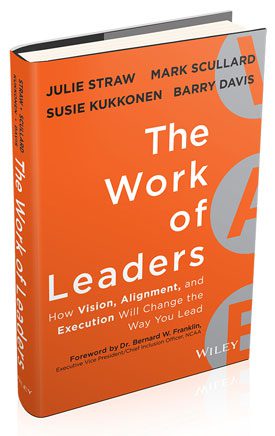
When Wiley’s assessment team (formerly Inscape Publishing) was looking to create a leadership assessment they started by asking a simple question:
What is the most impactful work that leaders actually do?
What they found was that there are thousands of papers and books that all provide nuanced answers to this simple question. Some of the research and literature were good. Some of it wasn’t so good.
So, like any good researcher, the team spent 5-years digging through the research, conducting interviews with executives, and surveying organizations to answer this question. The result was a new leadership model that was presented in the book titled The Work of Leaders.
The leadership model points to three areas that when performed by Executives are most impactful for the organization:
This model is called VAE (Vision, Alignment, Execution). It is broken down into specific competencies and measured as a survey in the Work of Leaders assessment. The assessment shows a leader’s specific strengths and challenge areas based on their Everything DiSC Profile and the how they score against the VAE model.
The Vision, Alignment, and Execution act as sections within a journey. A leader must start the process with a Vision, move towards building alignment, and end on championing Execution.
Each section contains three primary drivers. A ‘driver’ is a foundational element that lays the groundwork for each step of the process and makes it achievable.
Within each of the drivers, are two best practices. These best practices are specific behaviors that support the driver. The best practices are used to measure how well the leader is able to perform the tasks within the VAE model. This map shows the full outline of the leadership model.
The result of this model is that leaders can use this Leadership Profile to determine how they need to adjust their behavior depending on which stage in the process they find themselves.
For example, the first best practice behavior within the Exploration Driver of the Crafting a Vision section is for leaders to remain open. This behavior is measured and represented in a leader’s profile. A leader will learn if they naturally align with this behavioral style or if they will need to cognizant of their preference to go against this part of the journey.
The leader will receive this type of information for every leadership behavior so they can continually question if they are choosing the right behavior based on what’s expected of them as a leader.

Many managers are promoted to their role because they were high-performing employees. Unfortunately, just because someone is a high performer, doesn’t necessarily mean that they will be a great manager.
Everything DiSC Management bridges this gap by helping managers understand how they prefer to manage and tools to understand how their direct reports want to be managed.
Managers can use this profile to adjust how they coach, delegate or managing depending on the direct report they are working with. The management assessment provides the following insights in the completed profile:
Front-line managers and supervisors will make or break an organization’s strategic goals. If a manager fails to motivate, engage, or instruct their team; organizational goals will fail. This management profile focuses on helping managers adjust how they communicate to their direct reports by using the DiSC model.
To help managers learn how to adjust their communication styles, the profile offers personalized feedback based on the manager’s behavioral profile.
When learning how to delegate, the learner receives specific tips based on style and their own behavioral style. These personalized tips make the content meaningful and easier to understand.
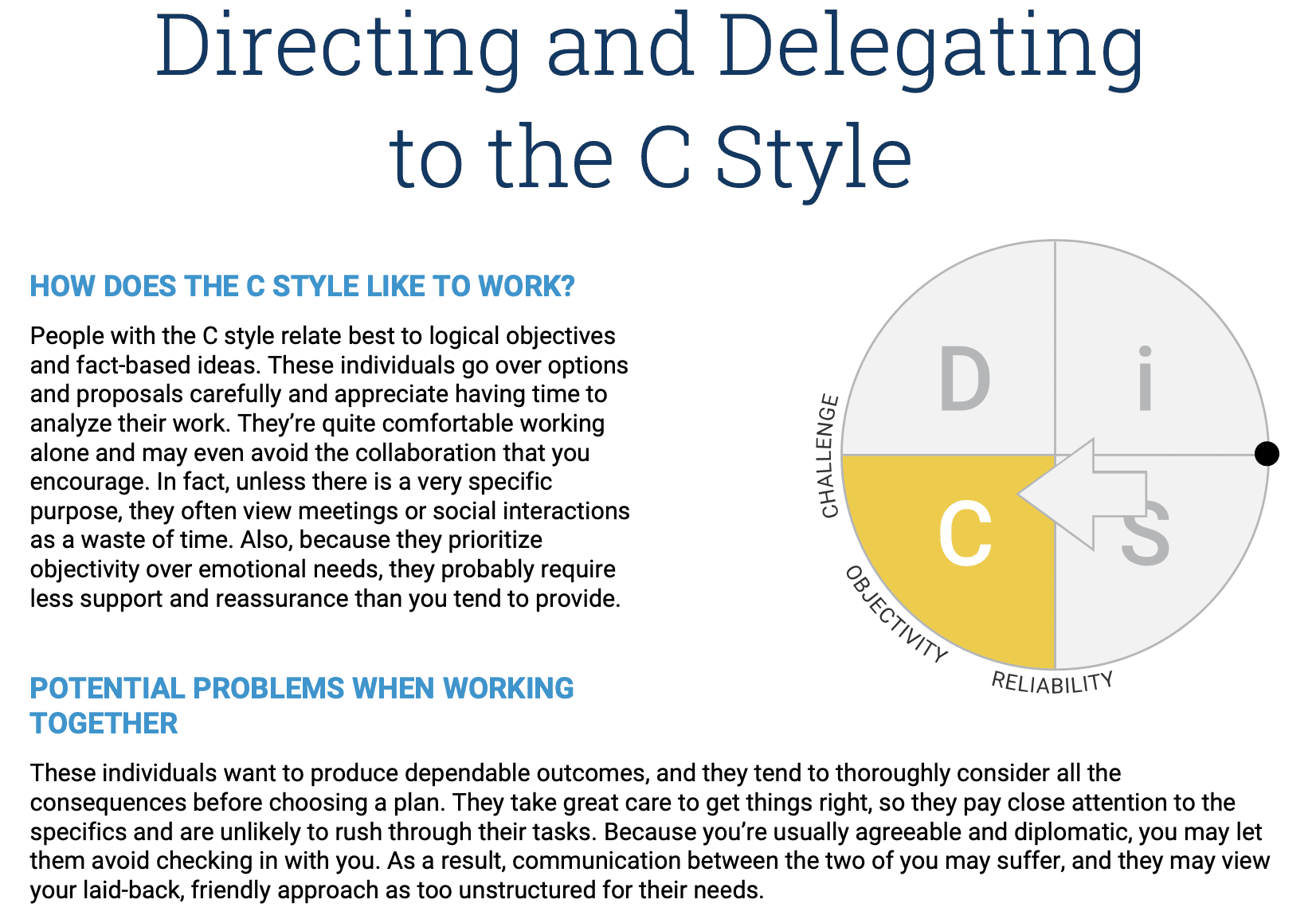
To further ensure that the content used and learned, Managers will also have access to unlimited comparison reports that they can use with direct reports who have an Everything DiSC report. Additionally, an online resource center called MyEverythingDiSC is available where they can compare their style on their own with direct reports, or other colleagues.

Daniel Goleman’s bestselling book from 1995, Emotional Intelligence, changed how we understood successful people.
In the book, Goleman outlines that many successful people aren’t necessarily the smartest and brightest. They are able to overcome adversity because they’ve learned how to control their response to what they are experiencing. This type of behavioral control is called emotional intelligence.
Everything DiSC Agile EQ improves emotional intelligence by using the DiSC framework to both improve self-awareness and social awareness. Through self-awareness, the tool is able to then teach both self-management and social management.
Today, teaching emotional intelligence (EQ) is increasingly important because it can help individuals and teams become more agile. The rate of change due to technology has never been faster and will only continue to increase. How we (individually or as a team/organization) respond to change largely depends on our emotional response. These responses are measurable and Agile EQ is able to identify what responses we typically prefer to use. In the Agile EQ profile, learners will discover their preferred ‘mindsets’ and which mindsets they might have a hard time using.
Agile EQ measures the following EQ Mindsets:
Self-Assured – Asserting your opinions and rights, projecting confidence in your ideas and abilities, and taking charge of situations
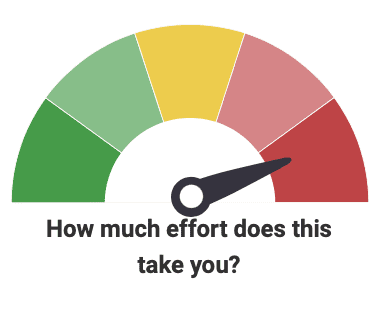
Agile EQ uses an effort meter to measure how well a person is able to use each different EQ mindset. The meter is used because regardless of how emotionally intelligent we are, there are times that we will fall back on our preferred mindsets. Ultimately, the more that a person practices choosing their emotional response, the more emotionally intelligent (and Agile) they will become.
To help continue practicing and learning about different emotional responses, Agile EQ is not on Catalyst – a learning platform that is only available with Everything DiSC.

Workplace conflict is frequently viewed as a negative interaction. And, often it is negative.
When a workplace discussion about an idea, strategy, or issue becomes heated, it’s easy to feel like the person on the other side of the conversation is on the attack.
Potentially, they might be. However, it’s also possible that we are misinterpreting someone else’s behavior as threatening.
Everything DiSC Productive Conflict focuses on teaching what each behavioral style looks like in conflict and how an individual can prevent conflict from becoming destructive. The profile covers the following training topics:
The Productive Conflict profile is powerful because it uses a method that is commonly used in therapy by many psychologists today. The profile generally teaches a process called Cognitive Behavioral Therapy (CBT). The process requires a person to recognize their thoughts and deciding if their thoughts match what is actually going on.
Once a learner is able to consistently identify their automatic thoughts, they are able to have more power over controlling if they will behave destructively. When these insights are shared across a team, conflict can become productive.
Research has shown that we are more likely to remember new information if we actively use it.
For that reason, Everything DiSC training programs encourage small group and partner discussions. There is less time in front of a facilitator explaining ‘what DiSC is’ and more time for learners to experience it themselves with their colleagues or co-workers. Additionally, the content is modularized so it can be delivered over half a day or over shorter sessions either in person or virtually.
For each Everything DiSC Application, there is a separate training program that will bring an individual’s report to life. Included within each set of facilitation materials are:
The activities and videos are combined to provide both small group and partner discussions.
During these discussions, learners will use their personal profiles to discuss and learn more about their own behavioral styles. Rather than discussing on the surface topics, learners are able to both explain how their own personal behavioral style has helped them at the workplace and then learn more about different behavioral styles. These conversations help facilitate a deeper connection amongst team members
To ensure that these conversations don’t lead towards ostracizing or criticizing someone based on their style, each session begins with a set of cornerstone principles that outline why a diversity of behaviors are beneficial for any team or organization. Take our DiSC Misfires quiz to learn more about the cornerstone principles.
Organizations and teams that want to run an Everything DiSC training program have two options to choose from:
Psychological instruments are used to measure abstract qualities that we can’t touch or see. These are characteristics like intelligence, extroversion, or honesty.
So how do researchers evaluate these instruments? How do we know whether such tools are actually providing accurate information about these characteristics or just generating haphazard feedback that sounds believable?
Simply put, if an instrument is indeed useful and accurate, it should meet a variety of different standards that have been established by the scientific community. Validation is the process through which researchers assess the quality of a psychological instrument by testing the tool against these different standards.
For over 40-years, Everything DiSC was built on a foundation of research. The original DiSC assessment was the DiSC Paper Profile (with the small ‘i’). This section is designed to help you understand these different standards and see how the Everything DiSC assessment performs under examination. For more detailed information, see the full Everything DiSC Research Report.
Validation asks two fundamental questions:
How valid is the tool? That is, researchers ask if an instrument measures accurately. The more that a tool measures what it proposes to measure, the more valid the tool is.
Note that no psychometric tool is perfectly reliable or perfectly valid. All psychological instruments are subject to various sources of error. Reliability and validity are seen as matters of degree on continuous scales, rather than reliable/unreliable and valid/invalid on dichotomous scales. Consequently, it is more appropriate to ask, “How much evidence is there for the reliability of this tool?” than, “Is this tool reliable?”
To determine if a tool is reliable, researchers look at the stability of the instrument and the internal consistency of the instrument. Stability is easy to understand. In this case, a researcher would simply have a group of people take the same assessment twice and correlate the results. This is called test-retest reliability. Internal consistency is more difficult to understand.
Here, we have the assumption that all of the questions (or items) on a given scale are measuring the same trait. As a consequence, all of these items should, in theory, correlate with each other. Internal consistency is represented using a metric called alpha.
We can use similar standards to evaluate both test-retest and alpha. The maximum value is 1.0 and higher values indicate higher levels of reliability. Although not set in stone, most researchers use the following guidelines to interpret values: above .9 is considered excellent, above .8 is considered good, above .7 is considered acceptable, and below .7 is considered questionable. The reliability estimates for the eight DiSC® scales are shown in Table 1.
We can use similar standards to evaluate both test-retest and alpha. The maximum value is 1.0 and higher values indicate higher levels of reliability.
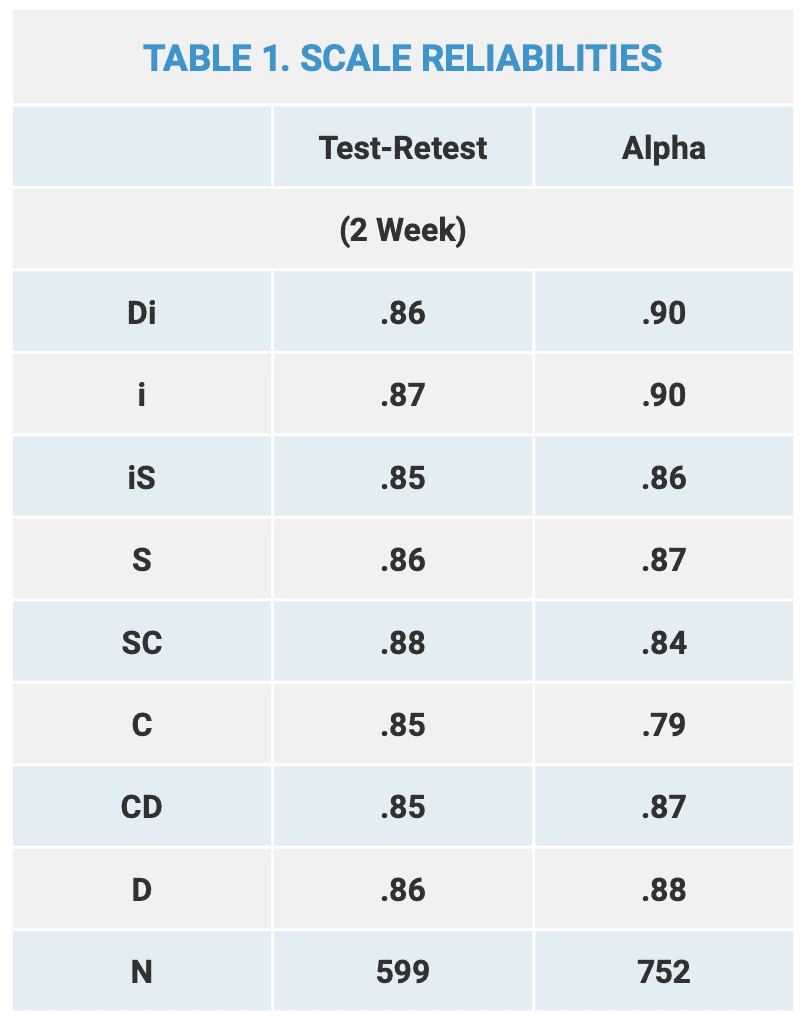
Although not set in stone, most researchers use the following guidelines to interpret values: above .9 is considered excellent, above .8 is considered good, above .7 is considered acceptable, and below .7 is considered questionable. The reliability estimates for the eight DiSC® scales are shown in Table 1.
There are many different ways to examine the validity of an assessment. We will provide two such examples here, but many more are included in the full Everything DiSC Research Report.
The DiSC model proposes that adjacent scales (e.g., Di and i) will have moderate correlations. That is, these correlations should be considerably smaller than the alpha reliabilities of the individual scales. For example, the correlation between the Di and i scales (.50) should be substantially lower than the Alpha reliability of the Di or i scales (both .90). On the other hand, scales that are theoretically opposite (e.g., i and C) should have strong negative correlations. Table 2 shows data obtained from a sample of 752 respondents who completed the Everything DiSC assessment. The correlations among all eight scales show strong support for the model. That is, moderate positive correlations among adjacent scales and strong negative correlations are observed between opposite scales.
Cronbach’s Alpha reliabilities are shown in bold along the diagonal, and the correlation coefficients among scales are shown within the body of the table. Correlation coefficients range from -1 to +1. A correlation of +1 indicates that two variables are perfectly positively correlated such that as one variable increases, the other variable increases by a proportional amount. A correlation of -1 indicates that two variables are perfectly negatively correlated, such that as one variable increases, the other variable decreases by a proportional amount.
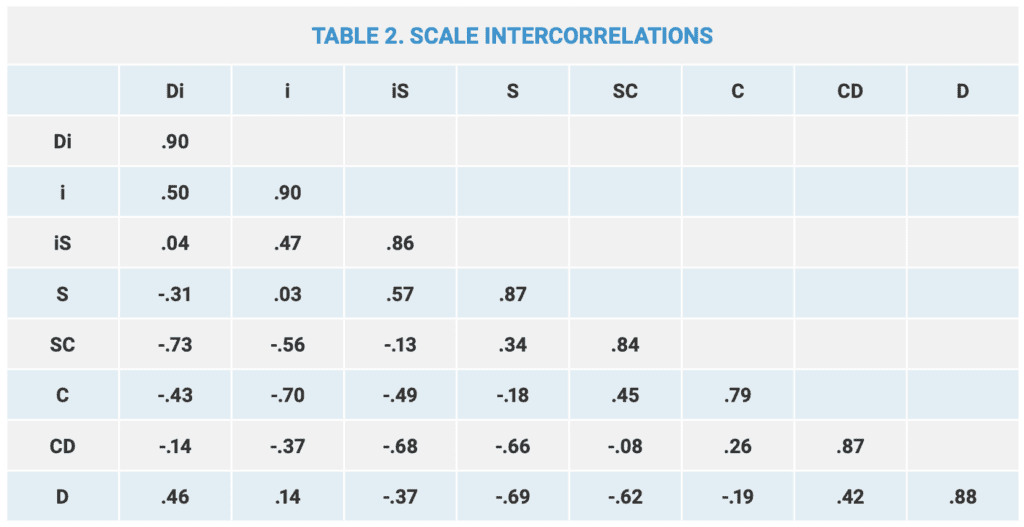
A correlation of 0 indicates that two variables are completely unrelated; N=752, as shown in Appendix 1 of the Everything DiSC
Research Report.
A statistical technique called multidimensional scaling also adds support to the DiSC model as a circumplex. This technique has two advantages. First, it allows for a visual inspection of the relationship among the eight scales. Second, this technique allows researchers to look at all of the scales simultaneously.
In Figure 1, scales that are closer together have a stronger positive relationship. Scales that are farther apart are more dissimilar. The circumplex DiSC model predicts that the eight scales will be arranged in a circular format at equal intervals.
As can be seen in Figure 1, the scales are arranged in a way that is expected by the DiSC model. (Keep in mind that the original MDS rotation is presented below and this rotation is arbitrary.) Although the eight scales do not form a perfectly equidistant circle (as predicted (as predicted by the model), this theoretical ideal is nearly impossible to obtain with actual data. The actual distance between the scales, however, is roughly equal, providing strong support for the model and its assessment.
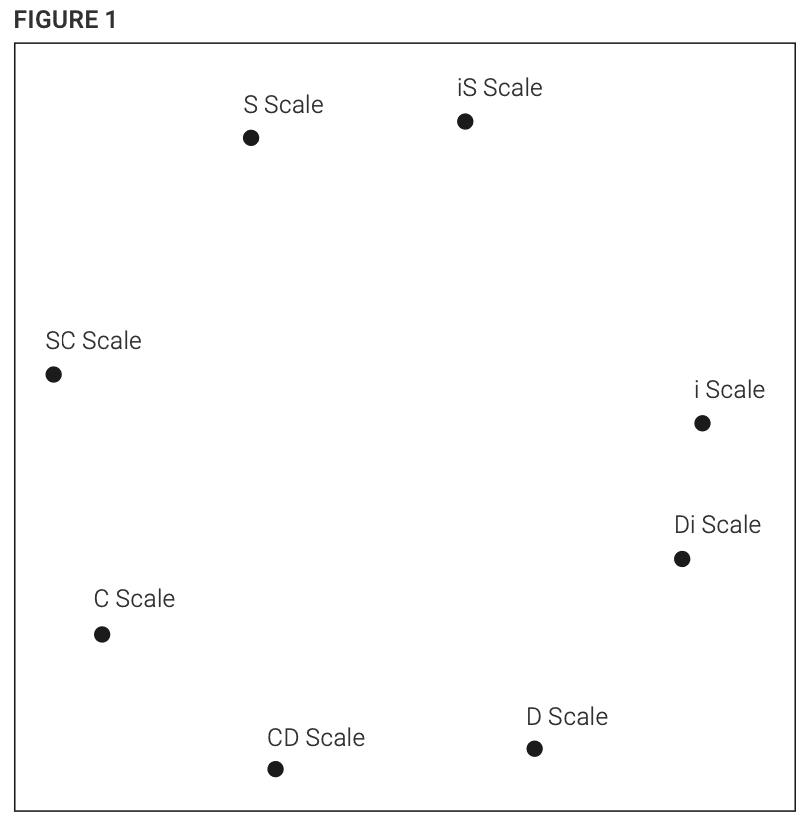
Want to learn more? The Everything DiSC Research manual is available for purchase. Check out this powerful research tool if you are interested in digging more into how this model was developed and how it compares to other psychological assessments.
© 2023 Center for Internal Change | All rights reserved